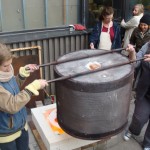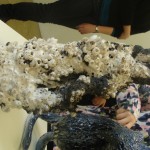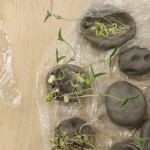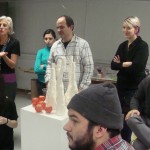teaching
I am a teaching artist—I make teaching an integral part of my professional practice as an artist. I teach ceramics on a part-time basis within the studio Arts department at Concordia University. I also teach art to young children as a supplementary teacher.
There is an incessant cross-pollination between different aspects of my life. My art practice, teaching, my role as the mother of three teenagers/young men, my keen interest in flora and in the human soul, are not mutually exclusive spheres of reality. It all intermingle and revivify one another. I see being a professional practicing artist as a way of keeping my teaching alive and keen. In turns, being a teacher nourishes my own research and art making.
I recognize art as a weaving-making activity connected to life and everything else, and see art at the service of life (Allan Kaprow). After all, life itself can be approached as a creative challenge; through the medium of whatever we do on a daily basis whether it be making a print or cooking a meal, relating to others, addressing the challenges of our occupations.
For me, one of the characteristic of vital pedagogy is that it continually calls into question its borders, that is to say, its taxonomies, its formation. When reflecting on my position towards teaching, I find it pertinent to keep in mind that “ to educate (educare) means to drive outside, therefore out-of-oneself, towards the Other…”.(1)
The metaphor of having to leave oneself in order to have access to knowledge seduces me. In this perspective, education can be understood as a journey from the self towards otherness, towards the unknown, the unresolved, towards ways to apprehend the crucial notion that everything is connected. Paradoxically, an unflinchingly sincere and evolving self -knowledge and a long-term commitment to oneself are the keys to open up.
My aim is to encourage students in developing and nourishing their own innate artistic spirits and abilities, their creative and critical imagination, in order to construct thought, action and the pleasure of doing.The most effective way to teach seems to be by favorizing the interaction between knowledge and autobiography, between the subject and the self, while working at the juncture of ideas and intuitions.
“The major ideas at the core of every discipline arose from the real life of a real person, not from the mind alone, but from the thinker’s psyche, body, realtionships, passions, political and social context.” (2)
I invite students to introduce their own vision in their work: their ideas, thoughts, emotions, intuitions, interests, desires, expectations, aspirations, in order for them to deploy a curiosity about the self.
From there, it is possible to open up to the family, friends, the city where one lives, the rich history of ceramics and art, the larger continuum from which we are a part.
In this way, we can go beyond autobiography to meet larger realities based on the recognition and respect of difference, on the importance of the relation to others, to society, to the environment, to life.
In my opinion, one important role an artist should be able to engage in is a consciousness raising of small things from everyday life which weave everyone’s experience. Thus, the different ways to apprehend reality can be revisited. Spaces for care and compassion can be planned. Focusing on relatedness becomes possible. Art has the potential of proposing other ways of seing and perceiving if artists are committed to living attentively.
I see the notion of invention as the key intellectual act where my teaching should lead. This orientation enables the students to create unfamiliar links between things, to experience things differently, to remodel preconceived ideas, to imagine the unimaginable…
I also want to focus on the understanding that form and content, practice and theory, context, intellectual meaning and “ experienced meaning” (Allan Kaprow) all compose an organic rhizomic whole of unfolding information and matter.
The production in contemporary ceramics is to be understood as an immensely rich equation going far beyond an autonomous aesthetic culture. It is my responsability as an art teacher to enable the unfolding of a variety of attitudes, viewpoints, and visual languages marking out this ever-changing discipline.
As a teacher, I am a guide, a collaborator facilitating a situation where students can teach themselves and teach others.I do so while sharing my own sensibility, my convictions, my savoir-être and my savoir-faire. Ultimately, I am acting as a catalytic agent in communicating my enthusiasm, my curiosity and my passion for art and life, hoping it will be contagious!






